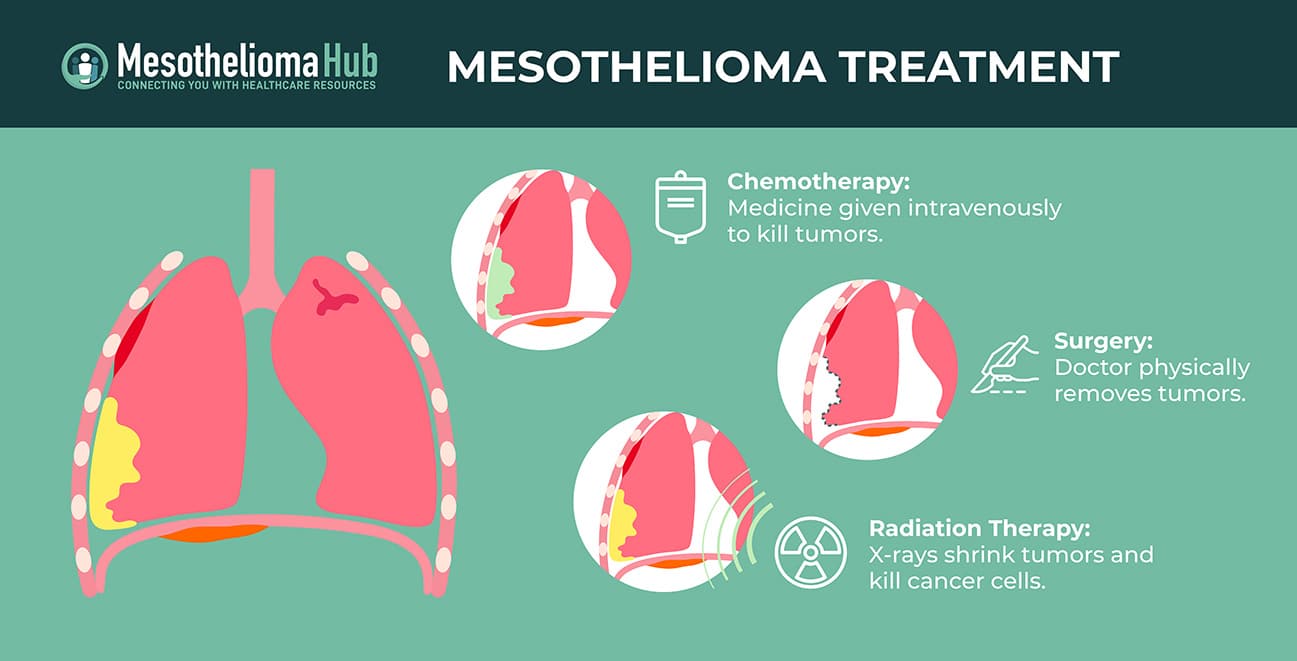Medically Reviewed by: Alicja Gruszka, MD PhD | February 13th, 2024
Treatment for lung cancer, a type of cancer that forms in the lungs and is the leading cause of cancer-related deaths worldwide, can vary depending on factors such as the cancer stage and cell type, patient age, and overall prognosis. After a lung cancer diagnosis, the best forms of treatment are discussed between you and your care team.
Navigating through mesothelioma treatment options can be a complex journey, as the recommended course of action depends on various factors unique to each individual. Factors such as the location of mesothelioma, the disease’s stage, the patient’s overall health, and treatment history play a pivotal role in shaping the personalized treatment plan crafted by doctors. When a doctor develops a treatment plan for their patient, the details hinge on several factors that differ with each individual. These factors include:
If you develop and are diagnosed with any of these diseases from exposure to asbestos or another toxic substance (or for any other reason), talk to an oncologist about what their recommendations may be for therapy. Each patient will have a different prognosis that can potentially be improved.
Mesothelioma Advocates
Kelsey Staub

Doctors and researchers have tested and developed three primary modes of treatment for mesothelioma patients: surgery, chemotherapy, and radiation. These therapies can be used alone or in conjunction at different intervals and levels, also known as multimodal therapy. Additionally, the doctor may choose to administer these treatments curatively (to try and cure the disease) or palliatively (to relieve symptoms).
A doctor may recommend surgery to completely remove the tumor by making an incision and removing the affected tissue with a surgical tool. If the surgeon can’t remove all of the tumors, chemotherapy or radiation may be administered to kill the remaining tumor cells.
There are a few ways a surgeon may choose to treat a mesothelioma patient, such as Debulking, which involves reducing as much of the bulk (volume) of a tumor as possible without the intention of complete eradication. If the patient has tumors on the lining of the lungs (pleural space), the doctor may choose a pleurectomy. When tumors develop in the lining of the abdomen (peritoneal area), the surgeon may recommend a peritonectomy. When tumors are in the lining of the heart (pericardial), treatment options are severely limited due to the tumor’s sensitive location and proximity to a major organ, but surgery can sometimes be applied.
Sometimes called ‘chemo,’ chemotherapy involves the utilization of anti-cancer medications injected or orally into the body. Depending on the location and progression of the tumors, a doctor can choose to administer the drugs to a patient in many ways. The most common way is intravenous, which involves the doctor injecting the medications through a vein.
A nurse, following the doctors’ orders, will administer chemotherapy medication through the vein to a specific area (regional chemotherapy) or throughout the entire body (systemic chemotherapy). Medications are commonly administered together before or after surgery. Newer targeted methods are being developed that aim to reduce chemotherapy side effects by directing the anti-cancer drugs to specific regions, but they’re currently being tested in clinical trials.
Doctors can use high-energy X-rays to attack tumors deep within the body. There are two primary types of radiation treatment: external beam radiation therapy (EBRT) and brachytherapy. Brachytherapy is a type of radiation therapy in which a sealed radiation source is placed inside or next to an affected area requiring treatment.
There are also several subtypes that differ based on how the doctor administers the radiation beams and what types of beams are used. It can be challenging to focus the beams on mesothelioma tumors because they tend to grow and spread, so this mode of treatment is generally used after surgery or chemotherapy to try to kill the remaining cells.
Targeted therapy medications function differently from other medicines because they can target specific cells, versus other anti-cancer drugs that tend to affect all cells, even healthy ones.
These treatments are much newer than the previous three modes of therapy for malignant mesothelioma. Still, due to success in clinical trials, they have become more common in current patient treatment plans. Still not tested enough to be considered primary, targeted therapies will soon be regarded as standard anti-cancer therapy due to the lack of adverse reactions from medications, since they can be focused on a specific area. Immunotherapy is the most common type of targeted treatment doctors use in cancer patients today.
There are a few helpful things you can do to help better prepare for cancer treatment. One significant detail is to ensure you understand everything that’s happening during your mesothelioma treatment.
Don’t be afraid to ask your doctor more questions about any aspect of your treatment, diagnosis, prognosis, or post-treatment, among other things. You’re also entitled to a second opinion with a different oncologist if you wish. Other ways to prepare include:
There are 3 phases of cancer therapy: neoadjuvant, surgery, and adjuvant. Neoadjuvant therapy consists of all treatments and therapies the doctor chooses to administer before the primary, while adjuvant encompasses all regimens the doctor administers after primary treatments. Tumors developing in the pleura versus other locations allow the doctor a different set of treatment options. Modes of treatment generally administered to pleural mesothelioma patients include surgery, chemotherapy, and radiation. Sometimes, these are combined with newer treatments like immunotherapy.
Methods that surgeons generally perform on pleural mesothelioma patients include pneumonectomy, pleurectomy, and partial pleurectomy.
Researchers are still discovering other methods to administer chemotherapy medications to greatly reduce adverse reactions from the chemotherapy drugs in the bloodstream. Hyperthermic intrathoracic chemotherapy (HITHOC) has been proving helpful in the treatment of pleural mesothelioma.
This therapy for pleural mesothelioma patients has two main types: 3DCRT and Intensely Modulated Radiation Therapy (IMRT). Both of these are subtypes of external beam radiation.
The peritoneum refers to the lining in the abdomen that surrounds the organs. Tumors in or around the abdomen are harder to treat with radiation because they can cause too much damage. Surgery and chemotherapy are more common choices when a person is diagnosed with this mesothelioma type.
Since pericardial mesothelioma involves tumors around the lining of the heart sac, this area is very sensitive and hard to treat. A Pericardiectomy is a surgical procedure that removes parts or all of the pericardium. Radiation usually does too much damage, so this treatment mode is usually not selected for pericardial mesothelioma patients. For this reason, chemotherapy can also be difficult for doctors to administer safely to patients. While numerous cases of pericardial mesothelioma are inoperable, surgery is still the primary treatment of choice for this disease.
Pain management is the main focus of palliative care and is generally recommended for late-stage patients. The care provider is also trained to recognize psychological disorders that may develop and assign treatment or therapies accordingly. If a patient is too late in their stage of mesothelioma, primary modes of treatment may be utilized for palliative care only. Types of palliative treatments for mesothelioma include:
Targeted therapies like immunotherapy are considered new and emerging treatments, but are the most successful ones currently. Recently, in first-line treatment, immunotherapy combining nivolumab with ipilimumab has been shown to be superior to chemotherapy in the CheckMate-743 study in terms of overall survival (18.1 months), leading to its approval by the FDA and EMA (PMID: 38136333). Some specialty centers administer these types of emerging therapies, but most of the time, clinical trials are the best way to find other new treatment options that may not be as available to the public as immunotherapy.
Alternative and complementary therapies aren’t scientifically backed and proven to work, but some people have reported improvements in their prognosis, physical health, or outlook. Additionally, they’re never meant to replace primary treatments and should always be discussed with a doctor beforehand. Some therapies include:
In the United States, costs to treat mesothelioma can add up. In 2014, enough data was gathered to average the mean cost of treatment per hospitalization to $24,124. It can also greatly exceed this number when multiple treatments are added in. This doesn’t include out-of-pocket expenses for complementary therapies, some clinical trials, or loss of income from having to take off work.
Contact our patient advocates for a case evaluation if you were negligently exposed to asbestos or other toxic products at work or otherwise. Any money gained from a potential legal case can offset or completely cover the costs of treatment and any financial loss that may come from having to leave your job.
Jennifer Verta thrives as a digital content writer at Mesothelioma Hub. She has been producing content for clients since before she graduated from the University of Colorado at Denver with a Bachelor of Arts in Communication and a Minor in English Writing. Jen’s mission is to help promote awareness of mesothelioma to as many people as possible by providing only the most up-to-date and accurate content available. When she isn’t cranking the gears at work, Jen can be found snowboarding, hiking, catching live music, or socializing with friends.

Dr. Alicja Gruszka is a biomedical science researcher with a medical degree from the Jagiellonian University in Krakow. Her illustrious academic journey includes completing a PhD at the Institute of Cancer Research, University of London, and engaging in post-doctoral fellowships in Milan and London. Dr. Gruszka has over a decade of research experience in the Department of Experimental Oncology, IEO, and Milan. Dr. Gruszka helps Mesothelioma Hub’s writers and editors and reviews medical content to ensure we provide accurate and insightful information about oncology and cancer.
Abraham, J. (2009). Palliative Care for the Patient with Mesothelioma. Retrieved on December 8th, 2020, from https://pubmed.ncbi.nlm.nih.gov/19822289/
American Cancer Society. (2018). Chemotherapy for Malignant Mesothelioma. Retrieved on December 4th, 2020, from https://cancer.org/cancer/malignant-mesothelioma/treating/chemotherapy.html
American Cancer Society. (2019). Getting External Beam Radiation Therapy. Retrieved on December 6th, 2020, from https://cancer.org/treatment/treatments-and-side-effects/treatment-types/radiation/external-beam-radiation-therapy.html
American Cancer Society. (2018). Radiation Therapy for Malignant Mesothelioma. Retrieved on December 6th, 2020, from https://cancer.org/cancer/malignant-mesothelioma/treating/radiation.html
American Cancer Society. (2018). Surgery for Malignant Mesothelioma. Retrieved on December 3rd, 2020 from https://cancer.org/cancer/malignant-mesothelioma/treating/surgery.html
American Cancer Society. (2018). Targeted Therapy for Malignant Mesothelioma. Retrieved on December 7th, 2020, from https://cancer.org/cancer/malignant-mesothelioma/treating/targeted-therapy.html
Borelli, E., et. Al. (2019). Costs of Medical Care for Mesothelioma. Retrieved on December 9th, 2020 from https://ncbi.nlm.nih.gov/pmc/articles/PMC6637828/
Cancer Research UK. (2018). Surgery for Peritoneal Mesothelioma. Retrieved on December 6th, 2020, from https://cancerresearchuk.org/about-cancer/mesothelioma/treatment/surgery/peritoneal-mesothelioma
Cancer Research UK. (2018). Surgery for Pleural Mesothelioma. Retrieved on December 6th, 2020, from https://cancerresearchuk.org/about-cancer/mesothelioma/treatment/surgery/pleural
Cleveland Clinic. Pericardiectomy. (N.D.) Pericardiectomy. Retrieved on December 8th, 2020, from https://my.clevelandclinic.org/health/treatments/17352-pericardiectomy#:~:text=Pericardiectomy%20is%20the%20surgical%20removal,pumping%20movements%20within%20the%20pericardium.
Eckland, K. (2019). Hyperthermic Intrathoracic Chemotherapy. Retrieved on December 8th, 2020, from https://americanphysiciansnetwork.org/tags/hyperthermic-intrathoracic-chemotherapy/
Enomoto, L. et. Al. (2019). Cytoreductive surgery with Hyperthermic intraperitoneal Chemotherapy for Peritoneal Mesothelioma: Patient Selection and Special Considerations. Retrieved on December 7th, 2020, from https://ncbi.nlm.nih.gov/pmc/articles/PMC6511620/
Mercier, F. (2019). An Update of Peritonectomy Procedures Used in Cytoreductive Surgery for Peritoneal Malignancy. Retrieved on December 7th, 2020, from https://tandfonline.com/doi/full/10.1080/02656736.2019.1635717
Pagan, C. (N.D.) Before You Begin Cancer Treatment. Retrieved on December 7th, 2020, from https://webmd.com/cancer/features/before-you-begin-cancer-treatment#1
TexasOncology. (N.D.) Radiation Therapy for Malignant Pleural Mesothelioma. Retrieved on December 3rd, 2020 from https://texasoncology.com/types-of-cancer/mesothelioma/radiation-therapy-for-malignant-pleural-mesothelioma
Thorac, J. (2018). Surgery for malignant pleural mesothelioma: an international guidelines review. Retrieved on December 3rd, 2020 from https://ncbi.nlm.nih.gov/pmc/articles/PMC5830571/
Sugarbaker, P.H. (1995). Peritonectomy Procedures. Retrieved on December 7th, 2020, from https://ncbi.nlm.nih.gov/pmc/articles/PMC1234492/
UCSF. (2020). Malignant Mesothelioma. Retrieved on December 7th, 2020, from https://pedsurg.ucsf.edu/condition/rare-cancers-pediatric
WebMD. (2020). HIPEC (Hyperthermic Intraperitoneal Chemotherapy. Retrieved on December 8th, 2020, from https://webmd.com/cancer/what-is-hipec#1